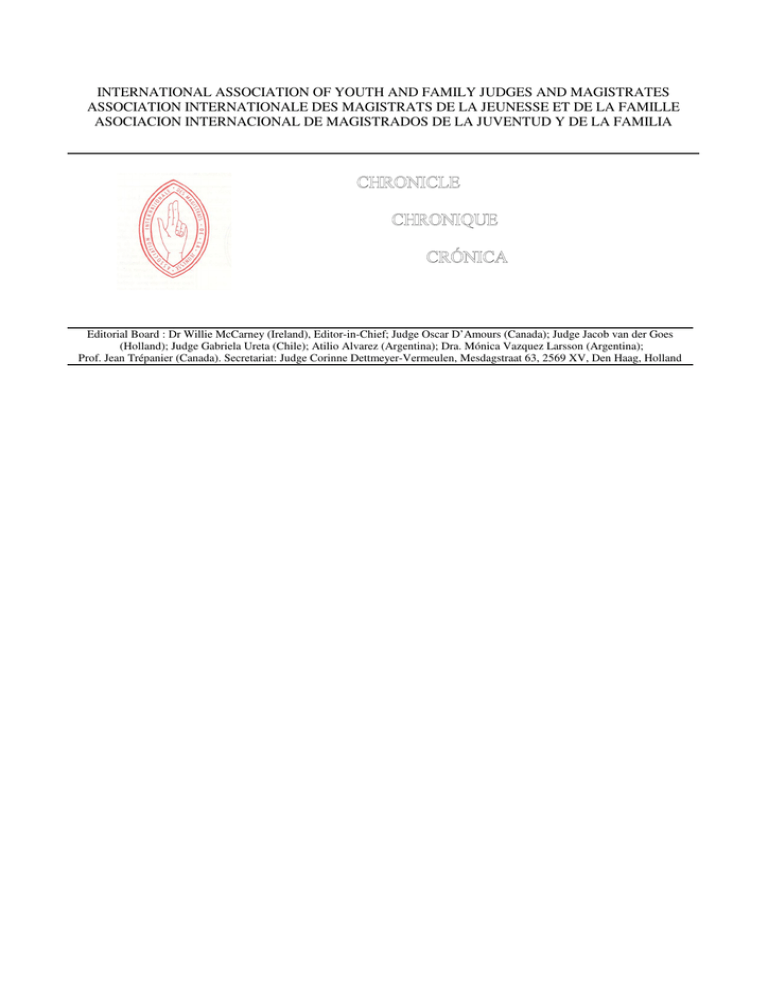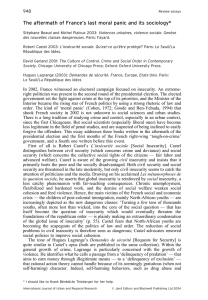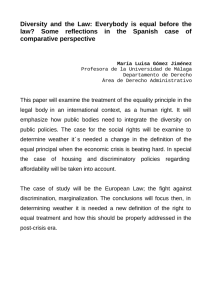international association of youth and family judges and magistrates
Anuncio

INTERNATIONAL ASSOCIATION OF YOUTH AND FAMILY JUDGES AND MAGISTRATES ASSOCIATION INTERNATIONALE DES MAGISTRATS DE LA JEUNESSE ET DE LA FAMILLE ASOCIACION INTERNACIONAL DE MAGISTRADOS DE LA JUVENTUD Y DE LA FAMILIA Editorial Board : Dr Willie McCarney (Ireland), Editor-in-Chief; Judge Oscar D’Amours (Canada); Judge Jacob van der Goes (Holland); Judge Gabriela Ureta (Chile); Atilio Alvarez (Argentina); Dra. Mónica Vazquez Larsson (Argentina); Prof. Jean Trépanier (Canada). Secretariat: Judge Corinne Dettmeyer-Vermeulen, Mesdagstraat 63, 2569 XV, Den Haag, Holland N. 2 Vol. 14 December/décembre/diciembre 2005 THE NEW SPANISH CRIMINAL LAW FOR MINORS AND JUVENILE DELINQUENTS Dr. José Luis de la Cuesta President of the International Association of Penal Law Director of the Basque Institute of Criminology (San Sebastián, Spain) Important changes in the justice system concerning the treatment of minors and juvenile offenders have taken place in Spain in the final decade of the last century (de la Cuesta, 1999, 101 ff.). Abolition of the tutelary system (1991-1992) Prosecutor and the Judge about the psychological, pedagogical and family situation of the minor and his background, in order to make it easier to take more relevant decisions concerning the minor’s education and social reintegration. The previous tutelary legislation (from 1948) was declared unconstitutional (by STC 14 February 1991) and Organic Act 4/1992 provisionally set up a hybrid model: tutelary / penal / social. As regards sanctions, new measures, not in the least imaginative (Manzana Laguardia, 1992, 2543) or novel (López Caballero, 1994, 548), took the form of educative interventions lasting up to a maximum of two years. The principle of flexibility in choosing, deciding and applying measures and reserving internment as a last resort were the main characteristics of the Act concerning this matter. This model –applicable to delinquents between 12 and 16 years of age – was first and foremost based on the principle of concern for the minor (Palacio Sánchez Izquierdo, 2000), considered to be the criterion governing intervention and which essentially boiled down to the minor’s education and social reintegration needs; not punishment or repression. Approval of a new Penal Code (1995) Consequently, the new penal process opened the way to the implantation of different means of distraction in the Anglo-Saxon line of diversion, making it possible to close proceedings without the imposition of measures, in view of certain circumstances: the crime’s severity, the minor’s circumstances and characteristics, the absence of violence or intimidation or the minor’s efforts to make amends with the victim. It also envisaged referring minors who had committed non-serious acts (which did not involve violence or intimidation) to the social services, either directly or with a warning. Moreover, the approval of a new Penal Code in 1995 in Spain had a decisive influence on the development of the new Juvenile Criminal Law. In fact, the new Penal Code raised the initial age limit for the application of its provisions to 18 and referred the prosecution of minors of that age to the Act regulating the penal liability of minors, thus maintaining the system introduced in 1992 temporarily in force. Organic Act 4/1992 also introduced technical teams, insistently requested by the authors (Beristain, 1995, XIV), formed by a psychologist, a social assistant and an educator. The “overriding role” (Urra Portillo, 1995, 8) of the team was to issue a report for the Public 11 N. 2 Vol. 14 December/décembre/diciembre 2005 Establishment of a new penal system of penal responsibility for minors and juvenile delinquents (2000) As an exception to the rule, youngsters over 18 and under 21 years of age might also be tried by means of juvenile jurisdiction (art. 4), providing that the crime was not serious and did not involve violence or intimidation towards people or jeopardize human life or physical integrity, that the subject has not been found guilty of committing criminal acts by binding judicial decision since reaching the age of 18 and that their circumstances and degree of maturity recommend following this procedure, especially if it is suggested by the technical team in its report. However, this possibility has still not come into force and it is temporarily suspended (until 2007). The new Act regulating the penal liability of minors (Organic Act 5/2000) was promulgated in January 2000, and came into force one year after its publication in the State Official Gazette (Boletín Oficial del Estado), that took place on 13th January 2000. Although the Act adopts the majority of changes introduced in 1992, an overriding transformation in the treatment of minors’ and juvenile delinquency has undoubtedly taken place1. 3. The minors and juvenile process is fully approved with regard to all matters concerning guarantees of the presumption of innocence and of the rights of defence, which leaves interesting possibilities open for exercising the “regulated” opportunity (Bueno Arús, 1997, 164) in proceedings. The Public Prosecutor’s participation is intense both in the investigation of facts and in the institution of proceedings. He must also ensure that juvenile rights are respected and watch over minors’ interests (art. 6). The Public Prosecutor can not take decisions restricting the fundamental rights of minors; this is the exclusive competence of the Juvenile Judge at the Public Prosecutor’s request and by justified ruling (art.23-3). 1. The Act clearly refers to the minor’s “penal” responsibility: a penal responsibility in the formal sense, that is governed by parameters similar to the those for adult liability, but is different from the latter with regard to its consequences, as it must lead to a nonpunitive reaction, which is materially educative. 2. Penal responsibility can be demanded for people aged between 14 and 18 years, (art. 1). The Act distinguishes between minors (14-18 years) and young people (over 18 years of age). Amongst minors, a distinction is also made between those who are 14-16 years old and those over 16 years of age, who may be subjected to longer-lasting internment measures (even for up to 8-10 years, followed by probation, in the case of very serious crimes or terrorist acts, respectively). Reaching adult age does not, however, put a stop to execution of the measure, which is pursued until proposed objectives are reached (art. 15). From the age of 23, youngsters are referred to one of the centres mentioned in the General Penitentiary Act (Ley Orgánica General Penitenciaria). 4. The Act includes a whole list of measures (art. 7)2 and regulates their application and execution, based on the legality principle (art. 43) and under the control of the Juvenile Judge. When imposing a measure, the facts and their legal qualification must be taken into account, but the minor’s age, family and social 2 Internment in a closed centre, in a semi-open centre, in an open centre; therapeutic internment; outpatient treatment; attendance at a Day centre; weekend stays; probation with intensive supervision; simple probation; living with a family or educative group; community services; carrying out socioeducative tasks; warning; deprival of motorcycle or motor vehicle driving licence, of the right to obtain them, or of administrative permits for hunting or fishing or the use of any type of weapon; absolute disqualification (this last measure, introduced by the reform brought about by Act 7/2000, of 22 December, concerns terrorism) 1 In summer 2004 was approved the administrative regulation necessary to assure the adequate application of the Act (see Royal Decree 1774/2004, of 30th July; published by the Official Journal –Boletín Oficial del Estado, 209- on 20th August 2004). 12 N. 2 Vol. 14 December/décembre/diciembre 2005 circumstances, personality and interest are more important aspects for consideration (art. 7.3). The execution of measures is the competence of Autonomous Communities and the proximity principle applies: the minor must be sent to the most suitable centre near his home, unless agreed otherwise by the Juvenile Judge in the interest of the minor. additional absolute disqualification (four to fifteen years). 5. As occurred with the previous legislation, Organic Act 5/2000 regulating the penal responsibility of minors also excluded “the actions by private people” (art. 25) and guaranteed the “monopoly of penal action” by the Prosecution Service. Victims could denounce, but it was the prosecutor’s task to accuse. This exclusion of the victim from the legal processing of the minor was criticized (Landrove Díaz, 1988, 293; Ventura Faci & Peláez Pérez, 2000, 124), although in exceptional circumstances the victim was allowed to participate during the instruction and also in the hearing regarding certain cases but in a limited way. Internment is divided into two phases: internment in the centre and probation (art. 7.2). Interment in a closed centre is only applied to intentional crimes with violence or intimidation or serious risk to human life or physical integrity (art. 9.2ª). The maximum duration of measures for criminal acts is two years, 100 hours, in case of community service, and 8 for the weekend stays (art. 9.3ª). Those over 16 years of age may be subjected to measures lasting up to 5 years, depending on the violence of the acts, the threat or serious risk to human life or physical integrity and whether the individual has educative needs that justify extending the measure3 In extremely serious cases (and repeated offences are always considered to be extremely serious) the judge may impose a measure of internment in a closed centre for one to five years and, then, probation for another five years; in these cases, modification or suppression of the measure can not be pronounced until after the first year of effective execution of the measure of internment (art. 9.5ª). Organic Act 15/2003 has put an end to this exclusion of the victim and has modified Article 25. This one allows the victim’s intervention as an actor in the penal process for minors. The exclusion of victims from the penal process has never affected their involvement in the process to establish civil liability. The civil process is examined in a ‘separate file’ (Article 61-64). Organic Act 5/2000 established indeed a new procedure, before the Judge of Minors but independent from the penal action and also regulated the liability of parents and legal guardians to pay victims compensation for damages caused by the minor’s behavior. 6. There are, finally, two legally approved possibilities for avoiding trial against a minor: Despite the above, for very serious crimes (homicide, murder, rape and qualified sexual assaults, terrorism and, in general, crimes punished by the Penal Code with penalties of over fifteen years’ imprisonment), the duration of interment is longer and may reach up to four years (five, for terrorist acts) for those under 16 years of age, and eight years (ten, for terrorist acts) for those over 16 years of age (Organic Act 7/2000, of 22 December), followed by probation and in cases of terrorism by an - abstention from starting proceedings on the part of the Prosecution Service for those acts which constitute misdemeanours or less serious crimes4, not involving violence or intimidation and whenever the minor has not committed similar acts in the past; and 4 In Spanish law, less serious crimes are generally those punished with less serious penalties; in general, in the case of imprisonment, those lasting three months to five years (art. 33.3, a) PC). 3 In these circumstances, community service may reach up to 200 hours and weekend stays up to 16 weekends (art. 9.4ª). 13 N. 2 Vol. 14 - December/décembre/diciembre 2005 acts and the absence of any of the circumstances of exemption or extinction of the criminal responsibility envisaged by the Penal Code for adults. Thus there are already enough reasons for affirming that in Spanish Law the age limit for penal imputability (“irrefutable presumption of irresponsibility”) (Sánchez García de Paz, 2000, 706) has been nowadays fixed at 14 years of age (art. 3 Organic Act 5/2000) and that, between 14 and 18 years of age, penal imputability may occur. dismissal because of reconciliation or reparation (or a promise of reparation) between the minor and the victim (Article 19). According to Art. 19.2 of the Act “reconciliation has occurred when the minor recognises the harm caused and apologises to the victim and the latter accepts his apologies”; on the other hand, reparation is legally identified to “the undertaking assumed by the minor with the victim to perform certain deeds in the interest of the latter or the community and their effective completion”. In the event of non-compliance with the reparation or educative activity, case proceedings continue (art. 19.5). The act makes an important distinction between two age brackets (14-15; 16-17); but the difference of treatment is sometimes too great. With regard to those over 18 years of age, the best solution would be to refer them to the adult magistrate, authorising the latter to apply minors’ and juvenile legislation for matters concerning measures and possibilities of avoiding or suspending proceedings. 7. Brief comment Generally, there has been a need and demand for the Act for a long time. The text is positive because of its integral nature: it regulates all aspects of intervention regarding juvenile delinquents (14-18, exceptionally, 21), not only proceedings and measures, but also the principles to be applied, the execution of sanctions and civil liability. Proceedings are too similar to adult proceedings, even though there are large differences. In principle, possibilities open to diversion should be considered to be sufficient. The Public Prosecutor still has to perform an excessively wide range of functions and faculties. The regulation of preventive measures is too restrictive and the period of precautionary internment can be, in practice, too long. Conferring the prosecution of minors under the age of 18 accused of terrorist acts to the National Count of Justice (Audiencia Nacional) (brought in by Organic Act 7/2000) breaks the proximity principle and merely copies the system applied to adults. With regard to the technical team’s participation, greater emphasis should have been placed on communication between the technical team and the Juvenile Judge. Many points are worth commenting on. Let’s just briefly say that despite the great effort to make the educative model compatible with the sanctioning model and the guaranteeing model, looking to make solutions more flexible and to favour non-intervention... we are faced with outlooks and ideologies which are not always compatible. Moreover, it is based on the fundamental principle of greater concern for the minor; this continues to be, however, an ambiguous concept –concerning the minor’s personal development, his educative needs, his social reintegration -, which has not been sufficiently developed content-wise. In view of their regulation measures should be considered as genuine juvenile penalties (Cerezo Mir, 2000, 106; García Pérez, 2000, 686; Etxebarria Zarrabeitia, 2001, 32; against Feijoo Sánchez, 2001, 27 ff.), in other words, “punitive sanctions” (Sánchez García de Paz, 2000, 719). There is a broad list of measures, but there is also a lack of more imaginative According to Article 19 of the new 1995 Penal Code (Cuello Contreras, 2001, 49), the new system clearly refers to the penal responsibility of minors; this is upheld (Article 5 Organic Act 5/2000) in the commission of punishable 14 N. 2 Vol. 14 December/décembre/diciembre 2005 7/2000”. In Revista Jurídica Universidad Autónoma de Madrid, 4, 9 ff. García Pérez O. (2000), “La evolución del sistema de justicia penal juvenil. La Ley de Responsabilidad Penal del Menor de 2000 a la luz de las directrices internacionales”. In Actualidad Penal, 32, 682 ff. Gómez Rivero, M.C. (2001), “Algunos aspectos de la Ley Orgánica 5/2000, de 12 de enero, reguladora de la responsabilidad penal del menor”. In Actualidad Penal, 10, 163 ff. Lamo Rubio, J. (1999) “La víctima en el actual proceso de menores: presencias y ausencias”. In La Ley, núm. 4897, 1 ff. Landrove Díaz, G. (1998), La moderna victimología, Valencia. Landrove Díaz, G. (2001), Derecho Penal de Menores, Valencia. López Caballero, J.C. (1994), “La Legislación reformadora de menores en España u Brasil: un análisis comparativo”. In Revista de Derecho Penal y Criminología, 4, 491 ff. Manzana Laguardia, M.P. (1992), “Notas acerca del Proyecto de Ley sobre Reforma urgente del procedimiento de Menores”. In Revista General de Derecho, 571, 2543 ff. Palacio Sánchez Izquierdo, J.R. (2000) “El principio del superior interés del menor”. In Surgam, 466-467, 55 ff. Sánchez García de Paz, I. (2000) “La nueva ley reguladora de la responsabilidad penal del menor”. In Actualidad Penal, 33, 699 ff. Urra Portillo, J. (1995), Menores, la transformación de la realidad, Ley Orgánica 4/1992, Madrid. Ventura Faci, R. & Peláez Pérez, V. (2000), Ley Orgánica 5/2000 de 12 de enero reguladora de la responsabilidad penal de los menores. Comentarios y jurisprudencia, Madrid. solutions that could perhaps be put into practice through socio-educative programmes. Finally, the duration of interventions anticipated for extremely serious cases is generally considered as excessive. REFERENCES Beristain, A. (1995), “Prólogo”. In Urra Portillo, J. (1995), Menores, la transformación de la realidad, Ley Orgánica 4/1992, Madrid. Bueno Arús, F: (1997), “El Anteproyecto de Ley Orgánica reguladora de la Justicia de Menores elaborado por el Ministerio de Justicia”. In Eguzkilore. Cuaderno del Instituto Vasco de Criminología, 11, 159 ff. Cerezo Mir, J. (2000), Derecho Penal. Parte general. Lecciones, 2ª ed., Madrid. Cuello Contreras, J. (2001), El nuevo derecho penal de menores, Madrid, 2001. de la Cuesta, J.L.(1999),"El abandono del sistema tutelar: evolución del derecho español en materia de protección y de tratamiento de los menores delincuentes y en peligro". In Annales Internationales de Criminologie, 37 1/2, 101 ff. Etxebarria Zarrabeitia, X. (2001), “Aspectos sustantivos. Edad. Medidas. Contenido. Prescripción. Concursos. Régimen Transitorio”. In Consejo Vasco de la Abogacía (2001), La Ley Orgánica 5/2000 de Responsabilidad Penal de los Menores, Bilbao, 7 ff. Feijoo Sánchez, B. (2001), “Sobre el contenido y la evolución del Derecho Penal español tras la LO 5/2000 y la LO 15



